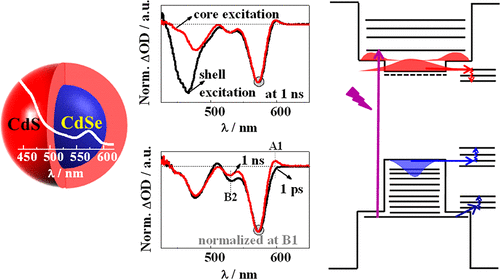当前位置:
X-MOL 学术
›
J. Phys. Chem. C
›
论文详情
Our official English website, www.x-mol.net, welcomes your
feedback! (Note: you will need to create a separate account there.)
Quasi-Type II Carrier Distribution in CdSe/CdS Core/Shell Quantum Dots with Type I Band Alignment
The Journal of Physical Chemistry C ( IF 3.3 ) Pub Date : 2018-05-07 00:00:00 , DOI: 10.1021/acs.jpcc.7b11684 Li Wang 1 , Kouhei Nonaka 1 , Tomoki Okuhata 1 , Tetsuro Katayama 1 , Naoto Tamai 1
The Journal of Physical Chemistry C ( IF 3.3 ) Pub Date : 2018-05-07 00:00:00 , DOI: 10.1021/acs.jpcc.7b11684 Li Wang 1 , Kouhei Nonaka 1 , Tomoki Okuhata 1 , Tetsuro Katayama 1 , Naoto Tamai 1
Affiliation

|
Band alignments are essential for understanding the optical properties and carrier transfer of core/shell QDs. As CdSe/CdS core/shell QDs with increasing shell thickness represent red-shifted absorption and luminescence spectra, weakened oscillator strength of the lowest electronic transition, and elongated luminescence lifetime, they are assigned to quasi-type II band alignment. However, femtosecond transient absorption spectroscopy with state-selective excitation revealed a type I band alignment of the CdSe/CdS QDs with a thin CdS shell, in which the excited electron is localized in the CdSe core with core excitation while delocalized in the whole QDs with shell excitation, even though a quasi-type II carrier distribution was observed with steady-state spectroscopy. In the type I core/shell QDs, the CdS shell acts as an energy barrier in surface electron and hole-trapping processes. The time constant of the hole-trapping process of the CdSe core (∼10 ps) was elongated 10 times owing to a tunnel effect through the high energy barrier of the CdS shell, which was estimated from the decay related to the biexcitonic induced spectral shift. The biexcitonic spectral shift induced by a ∼100 ps hole-trapping process was also observed at the 1S(e)–2S3/2(h) transition. Our results from transient absorption spectroscopy with state-selective excitation are useful to clarify band alignment and carrier distribution of hetero-nanostructures, which could help to objectively extract charge carriers in photovoltaic applications.
中文翻译:

具有I型能带对准的CdSe / CdS核/壳量子点中的准II类载流子分布
波段对准对于理解核/壳量子点的光学特性和载流子转移至关重要。由于壳厚度增加的CdSe / CdS核/壳量子点表示红移的吸收和发光光谱,最低电子跃迁的减弱的振荡器强度以及延长的发光寿命,因此将它们指定为准II型谱带对准。然而,具有状态选择激发的飞秒瞬态吸收光谱显示,具有薄CdS壳的CdSe / CdS量子点的I型能带对准,其中被激发的电子在中心激发下位于CdSe核中,而在整个QD中离域。即使使用稳态光谱法观察到了准II型载流子分布,也产生了壳激励。在类型I核心/外壳QD中,CdS壳层在表面电子和空穴俘获过程中充当了能量屏障。由于穿过CdS壳的高能垒的隧穿效应,CdSe核的俘获空穴的时间常数(约10 ps)延长了10倍,这是根据与双激子引起的光谱位移有关的衰减估计的。在1S(e)–2S处还观察到了约100 ps的空穴俘获过程引起的双激子光谱移动。3/2(h)转换。我们利用状态选择性激发的瞬态吸收光谱法得出的结果有助于阐明杂散纳米结构的能带排列和载流子分布,这有助于客观地提取光伏应用中的电荷载流子。
更新日期:2018-05-07
中文翻译:

具有I型能带对准的CdSe / CdS核/壳量子点中的准II类载流子分布
波段对准对于理解核/壳量子点的光学特性和载流子转移至关重要。由于壳厚度增加的CdSe / CdS核/壳量子点表示红移的吸收和发光光谱,最低电子跃迁的减弱的振荡器强度以及延长的发光寿命,因此将它们指定为准II型谱带对准。然而,具有状态选择激发的飞秒瞬态吸收光谱显示,具有薄CdS壳的CdSe / CdS量子点的I型能带对准,其中被激发的电子在中心激发下位于CdSe核中,而在整个QD中离域。即使使用稳态光谱法观察到了准II型载流子分布,也产生了壳激励。在类型I核心/外壳QD中,CdS壳层在表面电子和空穴俘获过程中充当了能量屏障。由于穿过CdS壳的高能垒的隧穿效应,CdSe核的俘获空穴的时间常数(约10 ps)延长了10倍,这是根据与双激子引起的光谱位移有关的衰减估计的。在1S(e)–2S处还观察到了约100 ps的空穴俘获过程引起的双激子光谱移动。3/2(h)转换。我们利用状态选择性激发的瞬态吸收光谱法得出的结果有助于阐明杂散纳米结构的能带排列和载流子分布,这有助于客观地提取光伏应用中的电荷载流子。







































 京公网安备 11010802027423号
京公网安备 11010802027423号